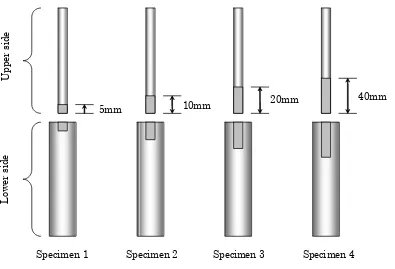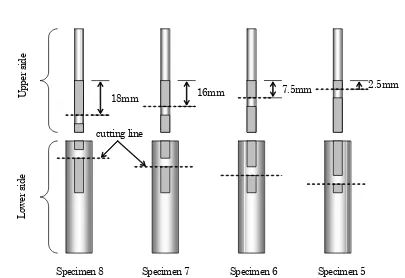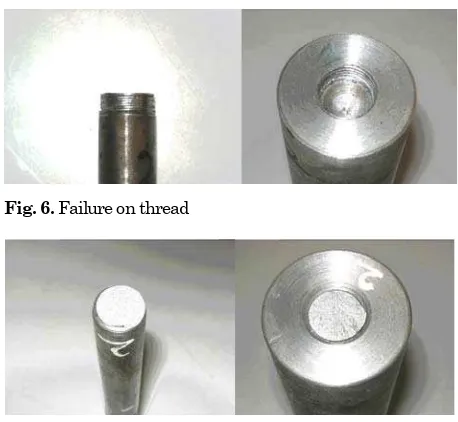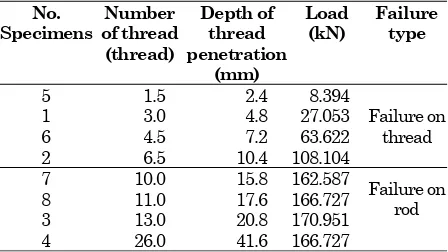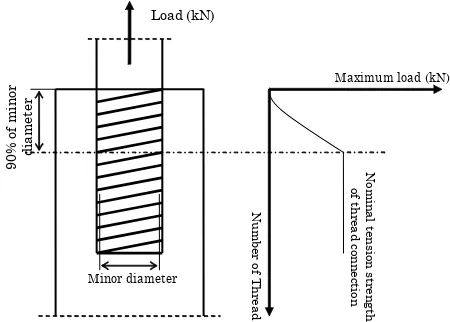The Tension Strength Experiment of Thread Connection Based on
The Depth of Thread Penetration
Agus Santosa Sudjono1, Lydia F. Tjong2, and Yohannes3
Abstract: Thread connection has been used for a long time. Presently, this kind of connection is the main connection in steel construction. This research aims to comprehend further the mechanism of the thread connection with respect to the depth of thread penetration. Tensile strength of thread connection was derived experimentally using two steel rods. The diameter of the first steel rod was ¾ inch (18.5 mm) and threaded on one end by 16 threads per inch. The diameter of the second steel rod was 45 mm and functioned as nut. From the results of the experiment, it can be concluded that rod failure will happen if the depth of thread penetration is equal to or bigger than 90% of nut minor diameter. Meanwhile, thread failure will happen if the depth of thread penetration is less than 90% of nut minor diameter. It is also shown that the correlation between the number of thread and the maximum load which can be supported by the connection is not linear.
Keywords: steel, tensile strength, thread, connection.
Introduction
Joint needs more attention than other parts of steel construction since nearly all steel construction failures happen due to joint failure [1]. Nowadays, bolted and welded joint are commonly used as parts of steel construction. Both joint types have advantages as well as disadvantages. If bolted and welded joint are designed properly, they will result in the same strength. The difference between these joint types is that bolt joint can be performed by untrained worker; meanwhile weld joint must be performed by certified welder.
Bolt and nut connection at steel joint starts working due to the application of shear force and/ or tension force in the longitudinal axis of the bolt. The strength of bolted joint is affected not only by the quality of steel, which is used as bolt material, but also by the strength of bolt and nut connection. The strength of this connection depends on thread size, thread length (number of thread), and the thickness of nut.
Mechanism to define bolt strength based on thread size, thread length, and nut size are commonly described in structural steel design textbook. In order
1Research Associate, Yokohama Engineering, Co. Ltd.
E-mail: [email protected]
2,3 Department of Civil Engineering, Parahyangan Catholic Univer-sity
Note: Discussion is expected before June, 1st 2008, and will be published in the “Civil Engineering Dimension” volume 10, number 2, September 2008.
Received 23 June 2006; revised 26 June 2007; accepted 22
Nopem-to improve the mechanism, researches regarding the correlation between tension strength of thread connection and thread penetration are considered necessary. This paper is a continuation of earlier studies on bolt and nut connection [2]. This research aims to figure out further the mechanism of thread connection. Result of the research will be used for creating a model of thread connection damage mechanism.
The mechanism of thread connection system, which is studied in this research, is the result of the tension strength experiment of thread connection, where the tension force is applied toward the longitudinal axis of the bolt. Two rods of steel were used in the experiment. The first rod functioned as bolt and the second rod functioned as nut. The second rod diameter was double the first rod size. A Universal Testing Machine (UTM) was used to pull out the thread. The capacity of this machine is 50 tons.
Specimens And Experiment Method
Parameter of Experiment
The main parameter is the depth of thread penetra-tion. Correlation between depth of thread penetration and nominal tension strength of thread system is summarized from the fickle depth of thread penetra-tion. The nominal tension strength is the maximum load, which can be supported by thread joint system, until the steel rod is broken. From this parameter, minimum thickness of nut and strength of one thread to bear tension load expectantly could be drawn.
done to find early estimation of correlation between the depth of thread penetration and the maximum strength of thread connection system. From the second experiment, it can be concluded more informa-tion on the correlainforma-tion.
Specimen Criteria
Since there is no standard to determine the dimen-sion and the shape of the specimen, the specimen was designed based on some logical considerations. Those criterias were:
a. The specimens contained two rods: upper rod and lower rod.
b. Thread was made on one part of the upper rod. The depth of thread penetration was changed until failures happened either on the thread or on the joint.
c. Threaded hole, which functioned as nut, was made on one end of the lower rod. The depth of the hole was similar to the length of the upper rod thread penetration. The diameter of lower rod was double the diameter of the upper rod in order to eliminate the effect of the lower rod on the depth of thread penetration.
d. This specimen should be able to be set properly on the 50 tons capacity UTM. The UTM is owned by the Structure Laboratory of Parahyangan Catho-lic University. Due to this reason, the length of upper rod and lower rod were made accurately so it can be handled by the UTM.
Specification of Thread
Table 1 shows thread size specification on the thread maker machine. This machine was used to make thread on specimens. The diameter of each thread was 18.5 mm (¾ inch) and threaded by 16 threads per inch (25.4mm).
Table 1. The thread size specification on thread maker machine
Rod diameter (mm)
Number of thread per inch (25.4mm)
18.5 (¾ inch) 4
18.5 (¾ inch) 10
18.5 (¾ inch) 16
18.5 (¾ inch) 20
18.5 (¾ inch) 40
First Four Specimens
For the first trial, four specimens were prepared as shown on Figure 1. These four cylinders were made based on the mentioned criterias. The length and diameter of first steel cylinder (upper side) were ± 280 mm and ± 18.5 mm respectively, with thread on one of its sides. The length and diameter of second rod (lower side) were ± 350 mm and ± 45mm respecti-vely. One side of the second rod functioned as nut. The thread penetration depth of specimen number 1, 2, 3, and 4 were 5mm, 10mm, 20mm, and 40mm respectively.
5mm 10mm 20mm
40mm
U
p
p
er
s
id
e
L
ow
er
s
id
e
Specimen 1 Specimen 2 Specimen 3 Specimen 4
Specimens 1 Specimens 2
Specimens 3 Specimens 4
Fig. 2. The first four specimens
Fig. 2 shows the four specimens. The material quality is adjusted to available material in the market. Only one kind of steel quality was used for this experi-ment. Table 2 shows mean value of specimen size measuring. The measuring was done with accuracy of 0.01 cm.
Table 2. The size of first four specimens
Speci-mens
Diameter of upper rod (mm)
Diameter of lower rod (mm)
Length of upper rod thread (mm)
Penetration depth of lower rod thread (mm)
Length of upper rod (mm)
1 18.3 45.0 4.8 4.8 255
2 18.4 45.0 10.4 10.4 250
3 18.4 44.8 20.8 20.8 260
4 18.4 44.9 41.6 41.6 249
Second Four Specimens
The second four specimens were prepared by re-designing the first four specimens. This method was possible since the lower and upper rod had not reached the ultimate strength yet. Therefore they were suitable to be used. Those rods were re-designed by eliminating the damage parts. Following this phase, the specimens were re-made like the first four specimens (Figure 3). The doted line is the cutting line.
Figure 4 shows the second four specimens after re-designing. The thread length of specimen number 5, 6, 7, and 8 were 2,5mm, 7,5mm, 15mm, and 18mm. Table 3 shows mean value of second specimen size measuring. The measuring was done with accuracy of 0.01 cm.
Specimens for Steel Quality Assessment
The rest parts of upper rods from second specimens were re-used as samples in next experiment to find out the steel quality. Average length and diameter of the specimens were 200mm and 18.5 mm. The specimen for steel quality assessment was the upper rod of specimen in tension strength experiment of thread connection. Because of the homogeneity of steel, only one rod was used for this experiment. The test was done by pulling the rod until it was broken. As the results, the ultimate tension and the maximum tension can be perceived.
7.5mm 16mm
18mm
U
p
p
e
r
si
d
e
L
ow
e
r
si
d
e
Specimen 8 Specimen 7 Specimen 6 Specimen 5 2.5mm
cutting line
Specimens 5 Specimens 6
Specimens 7 Specimens 8
Fig. 4. The second four specimens
Method of Thread Connection Tension Strength Experiment
Tension strength experiments for both first and second four specimens were done at the Structure Laboratory of Parahyangan Catholic University using the UTM. Its capacity is 50 tons. These specimens were pulled with the speed of 1.3–2.5 mm/minute toward the longitudinal axis of the specimens until the thread connection failed [3]. The maximum loads were noted down and some pictures of the thread connection failure types were taken to be visually analyzed.
Method of Steel Quality Assessment
The steel quality assessment was done at the Laboratory of Balai Besar Bahan dan Barang Teknik LIPI Bandung using the UTM. Its capacity is 50 tons. The specimen was pulled with the speed of 1.3 – 2.5 mm/minute until it was broken [3]. As the results of this experiment, the ultimate tension (Fy) and the
maximum tension (Fu) can be perceived.
Experiment Results
Used Steel Quality
From the experiment of steel quality, it can be summarized that the ultimate tension (Fy) and the
maximum tension (Fu) of steel are 518.4 MPa and
678.2 MPa. All of estimations done in this experiment were based on this value. Furthermore, it can be identified that the quality of steel used for this experiment was high. High quality steel is more brittle than average quality steel. This state is similar to joint system condition on building construction, which is generally composed from high quality steel.
Maximum Tension Load of Thread Connection
Table 4 and Figure 5 show the results of maximum tension strength experiment of thread connection
from the first and second series specimens. Due to the homogeneity of steel, the experiment of each specimen was done one time. It can be concluded that maximum strength of thread connection will increase as thread penetration is deepened.
Table 4. Maximum tension load
No. Specimens
Number of thread (thread)
Depth of thread penetration
(mm)
Load (kN)
1 3.0 4.8 27.053
2 6.5 10.4 108.104
3 13.0 20.8 170.951
4 26.0 41.6 166.727
5 1.5 2.4 8.394
6 4.5 7.2 63.622
7 10.0 15.8 162.587
8 11.0 17.6 166.727
0 50 100 150 200
0 5 10 15 20 25 30
Number of thread
M
a
x
imu
m l
o
a
d
(
k
N
)
Fig. 5. Relationship between number of thread and maximum load
Type of Thread Connection Failure
The types of thread connection failure can be classified into two groups, which are thread failure and rod failure. Figure 6 shows thread failure and Figure 7 shows rod failure.
Fig. 6. Failure on thread
Table 5. Specimen classifications based on the failure type
Table 5 shows specimen classifications based on the failure type. Failure of specimen number 1, 2, 5, and 6 occurred on the thread and failure of specimen number 3, 4, 7, and 8 occurred on the rod.
Thread failure occurred as the depth of thread penetration is less than 15 mm (specimen number 1, 2, 5, and 6). On specimen 1 and 5, where the thread penetration depth was short (4.8mm and 2.4mm respectively), thread on the top of the upper rod was damaged and the connection of the upper and lower rod were loose. Meanwhile, for deeper thread penetration (specimen number 2 and 6 with penetration of 10.4 mm and 7.2 mm respectively), all of the threads were crushed. In all instances threads on the lower rod were still in good condition.
The rod failure occurred if the depth of thread penetration was more than 15 mm (specimen number 3, 4, 7, and 8). The upper rod was broken on the border of thread and plain part. The fact showed that the strength of thread connection was bigger than the strength of the upper rod and this section was the weakest part of steel rod because of its smallest diameter. Due to high steel quality, the failure was not followed by large deformation.
Discussion
Nominal tension strength of thread connection
Nominal tension strength of thread connection is the maximum load that can be supported by the connec-tion. The nominal tension strength is depended on failure of steel rod or bolt. The equation from AISC-LRFD to calculate the nominal tension strength of thread connection is shown below [1].
(
u)
Ab is the gross area of steel rod or bolt longitudinal
section (mm2)
Fu is the maximum tension of steel rod (MPa)
Thread minor diameter is the diameter on the border of plain part and thread of upper rod. Minor diameter
) = 678.2 MPa, thus the nominal tension strength for the upper rod based on the equation (1) is 163.126 kN. The nominal tension strength of the upper rod based on the equation (1) is within the range of the experiment result (162.587 – 170.951 kN). Based on the AISC – LRFD equation, the maximum load from the experiment of specimen number 3, 4, 7, and 8 is comparable to the nominal tension strength. There-fore, it can be concluded that the average value of maximum load is the nominal tension strength of thread connection. The maximum load average value of specimen number 3, 4, 7, and 8 is 166.748 kN.
The nominal tension strength of thread connection can be derived from specimen number 3, 4, 7, and 8. In order to yield nominal tension strength, the minimum depth of thread penetration is 15.8 mm (specimen number 7), which is equal to 90.3% of the thread minor diameter. This result supports experi-ment done by Dose [4], that the depth of thread penetration is less than the rod minor diameter (approximately 90%).
Nominal Tension Strength of One Thread
Table 6 shows the number of threads and the maximum load of thread. It is can be summarized that the maximum load of thread connection is greater until the number of thread to 10 (the depth of thread penetration is approximately 90% of thread minor diameter). Following the stage, maximum load of thread connection becomes constant because the nominal tension strength has already been reached. Therefore, the nominal tension strength of one thread can be derived from the relationship between the amount of thread and the maximum load of thread connection if the penetration depth is less than 90% of the rod minor diameter.
Table 6. Relationship between the number of thread and maximum load of thread connection
Specimen
Figure 9 shows the result of correlation between the thread number of 1.5; 3; 4.5; 6.5; 10 and each maximum load that can be supported by them. A data is added to the prior data, thus the regression equation transgress the ordinate of (0,0). The data is thread amount and maximum load of zero. From the requisites, two regression equations are formulated.
x
Where, y is the maximum load that can be supported
Fig. 9. The correlation between number of thread and maximum load
Equation (2) is the linear equation, which means the maximum load that can be supported by the thread connection is equivalent to number of thread and nominal tension strength of one thread is 15.829 kN. Equation (3) shows the maximum load that can be supported by the thread connection is equivalent to number of thread to the 1.37th power and the nominal
tension strength of one thread is 6.7926 kN.
Determination coefficient (R2) shows accurateness
between the regression equation and data. The determination coefficient (R2) of one means the
regression equation accurately passes all points of data. Because the determination coefficient value of equation (3) is bigger than the determination coefficient value of equation (2), thus the equation (3) is more comparable than the equation (2). Moreover, as the nominal tension strength value of one thread, equation (3) is more suitable than equation (2) because the nominal tension strength value of one thread resulted by equation (3) is more rational and close to all data. Thus, equation (3) is proper to express the correlation between the thread amount and the maximum load.
The form of equation (3) informs about the nominal tension strength value of one thread and the existence of the thread is strengthening each other so the maximum that can be hold by the thread connection is comparable with the amount of the thread by the power bigger than 1. In this experi-ment, it is resulted that the nominal strength of one thread is 6.7926 kN and the power of the amount of the thread is 1.37.
Illustration of correlation between the maximum load and the number of thread is shown in Figure 10. Nominal tension strength of one thread as well as the power of thread number depends on the quality and the diameter of the steel. The minimum depth of thread penetration (number of thread) resulting the nominal tension strength is 90% from the rod minor diameter.
Fig. 10. Illustration of the correlation between maximum load and number of thread
Conclusion
Some conclusions can be derived from the results of experiment:
1) In order to achieve the nominal tension strength of thread connection, the minimum depth of thread penetration should be approximately 90% from the minor diameter of the rod.
2) Correlation between maximum load can be supported by the thread and the number of thread (if the depth of thread penetration less than 90% of steel rod minor diameter) is not linear.
3) The general equation of correlation between the maximum load that can be hold by the thread and the number of thread (if the depth of thread penetration less than 90% of steel rod minor diameter) is y = axn. Where, y is the maximum
load (kN), x is the number of thread, a is nominal tension strength of one thread (kN), and n is the power of thread number. From the experiment, it is resulted that the nominal tension strength of one thread is 6.7926 kN and the power of thread number is 1.37.
References
1. Segui, W. T.: LRFD Steel Design, third edition, Brooks/Cole–Thompson Learning, Pacific Grove, USA, 2003
2. Yohannes: The Tension Strength Experiment of Thread Connection, Thesis, Civil Engineering Department-Parahyangan University, 2005
3. ASTM designation: A 370-97a, Standard Test Methods and Definitions for Mechanical Testing of Steel Products, American Society for Testing and Materials, Philadelphia, 1997, pp. 164-216
